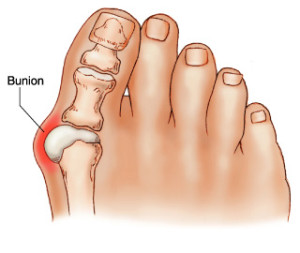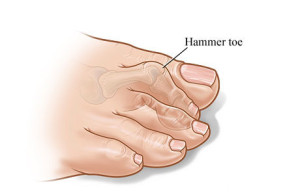Bunion
 A bunion, called hallux valgus, is a common but painful, bony bump that usually develops over time on the inner side of the foot near the base of the first/great toe. When a person has a bunion, there is an abnormal bone formation that causes the big toe to angle in toward the other toes.
A bunion, called hallux valgus, is a common but painful, bony bump that usually develops over time on the inner side of the foot near the base of the first/great toe. When a person has a bunion, there is an abnormal bone formation that causes the big toe to angle in toward the other toes.
Another type of bunion is called a bunionette, which is sometimes called a tailor’s bunion. The bunionette develops on the outside of the foot near the joint of the little toe.
A bunion can develop because of abnormal foot function or arthritis, likely secondary to Pes Plano Valgus (Flatfoot deformity). A common belief is that tight or improperly fitting shoes cause Bunion deformity. However, tight fitting shoes only exacerbate the symptoms. There also is a genetic aspect — a family history of bunions makes an individual more likely to develop his or her own bunion.
What are the symptoms of a bunion?
Bunions can be quite painful. Once one has developed, it may be extremely painful to wear any type of restrictive shoes. In addition, a bunion left untreated may lead to other foot problems, including corns, hammertoes, calluses and difficulty walking.
The symptoms of bunions include:
- Swelling or enlargement of the joint at the base of the big toe
- Movement of the big toe toward the other toes
- Tenderness over the bunion
- Red, calloused skin along the foot at the base of the big toe
- Joint pain
How is a bunion treated? Most bunions, particularly those in the early stages, can be treated conservatively. Surgery of the bunion is an option, but most physicians prefer to try non-surgical treatments first. Once a bunion has been diagnosed, a physician will first prescribe non-surgical treatments to relieve pain and try to limit the progression of the bunion’s development.
Non-surgical treatments may include the following:
- Wearing properly fitting shoes that are designed with a high, wide toe area to accommodate the forefoot area
- Wearing custom orthotic devices in the shoes to keep the feet properly aligned and stable, and to provide extra comfort, support and protection
- Using other products designed to accommodate and relieve bunions, such as felt or foam bunion pads and night-time toe spacers
- Using over-the-counter anti-inflammatory or pain medications
- Soaking feet in cold water for temporary pain relief
- Cortisone injection therapy
If the bunion gets worse and results in severe pain or deformity, a surgical bunionectomy can be effective. Surgery can relieve pain, correct foot deformities and help a person resume regular activities. There are several types of bunion surgery, depending upon the extent of the deformity. Most commonly, the surgery involves cutting of bone and correction of its alignment. The surgeon will also perform tendon rebalancing, thus repositioning the toe in the appropriate position.
The repositioned bone is stabilized with a screw, plate, or pins. Bunions generally take four to six weeks to heal. Crutches, a post-op shoe, or a cast may be used to keep the weight off the foot during the first months of recuperation. Although toe pain can be dramatically reduced after surgical removal of a bunion, patients will still have to practice good foot care afterwards to prevent the return of the bunion. This means wearing properly fitted shoes that do not squeeze the toes together and often wearing orthotic devices inside the shoes.
Hammertoe
 A hammertoe is a painful digital deformity whereby the end of a digit possesses a downward contraction. The contraction may involve either the proximal or distal toe joints. A hammertoe can occur in any toe, although it most often occurs in the second toe.
A hammertoe develops from a muscle imbalance that causes the ligaments and tendons to become unnaturally tight and buckle the joint. This causes the joint to curl downward.
There are several reasons a person may develop a hammertoe.
A hammertoe is a painful digital deformity whereby the end of a digit possesses a downward contraction. The contraction may involve either the proximal or distal toe joints. A hammertoe can occur in any toe, although it most often occurs in the second toe.
A hammertoe develops from a muscle imbalance that causes the ligaments and tendons to become unnaturally tight and buckle the joint. This causes the joint to curl downward.
There are several reasons a person may develop a hammertoe.
These reasons include:
- Wearing high heels or improperly fitting shoes that crowd the toes
- Having other underlying diseases such as multiple sclerosis, rheumatoid arthritis or diabetes that affect the feet and joints
- Suffering a traumatic injury
- Pressure from a bunion
- Flat feet
What are the symptoms of a hammertoe? Hammertoes can be quite painful. Once developed, extreme pain may follow. If left untreated, a hammertoe may result in a fixed rigid deformity where the toe cannot be straightened.
The symptoms of a hammertoe include:
- A claw-like deformity of the toe
- Redness and swelling around the affected toe
- Corn and/or callus formation along the top of the toe where it bends and rubs shoes
- Callus formation on the sole of the foot
- Joint pain in the toe
- Changes in gait or balance
How is a hammertoe treated?
Most hammertoes, particularly those in the early stages, are treated conservatively.
Non-surgical treatments may include the following:
- Wearing properly fitting shoes that are designed with a high, wide toe area to accommodate the forefoot
- Using foot manipulation and splints for the affected toe
- Strengthening toe muscles with exercises
- Wearing custom orthotic devices in the shoes to keep the feet properly aligned and stable, and to provide extra comfort, support and protection
- Using products such as corn pads or felt pads to help prevent irritation
- Using over-the-counter anti-inflammatory or pain medications
Surgical options:
If the hammertoe becomes fixed in a rigid position, surgery may be necessary to correct the deformity. There are several options a podiatric surgeon has, depending upon the severity of the deformity. The goal is to realign the toe thus improving function or to lengthen the tendons by removing part of the toe bone. Procedures may include releasing a contracted tendon and/or inserting a pin to correct the position of the toe. Almost all hammertoe surgery is done on an out-patient basis. Usually a patient will have to wear an open-toed surgical shoe for several weeks after the surgery.
